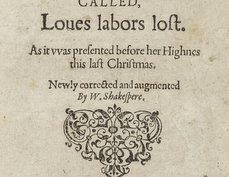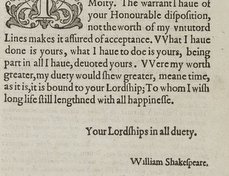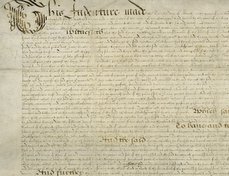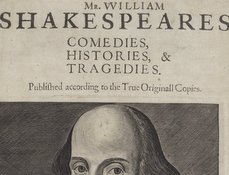On February 21, 1599, Sir Nicholas Brend and seven men associated with the Lord Chamberlain’s company of players signed a tri-partite lease for the site on Bankside, Southwark, on which the Globe playhouse would be built.
Brend, owner of the site by recent inheritance, leased the land for thirty-one years to two parties, each of which would control a “moiety,” or one-half of the lease. The first moiety was held jointly by Richard and Cuthhbert Burbage, sons of James Burbage, builder of the Theatre in 1576. The second moiety was held jointly by five senior fellows of the Lord Chamberlain’s Men: William Shakespeare, John Heminges, Augustine Phillips, Thomas Pope, and William Kemp.
The tri-partite lease would almost certainly have taken the form of an indenture.
While neither the original lease nor any registered copy survives, the form and the terms of the lease are attested in a long sequence of subsequent documents:
Inquisition Post Mortem of Thomas Brend (May 17, 1599)
Close Roll (October 7, 1601)
Close Roll (October 10, 1601)
Close Roll (November 11, 1608)
Ostler v. Heminges (1615)
Witter v. Heminges and Condell (1619)
Close Roll (February 21, 1622)
Close Roll (March 12, 1624)
Burbage et al. v. Brend (1632)
Benefield v. Burbage (1635)
Each of these documents names William Shakespeare as either the chief lessee of the Globe playhouse site, or as a co-lessee. The later documents tend to add more detail, both about the original lease and about changes in ownership of the individual shares over the years.
To take seven examples:
The Inquisition Post Mortem of Thomas Brend, dated May 17, 1599, contains the earliest surviving mention of the original lease. Thomas, father of Sir Nicholas and prior owner of the property, died five months before the date of the lease; by the same token, Sir Nicholas had just recently inherited the property at the time the lease was signed. William Shakespeare is the only member of the playing company specifically named in the inquisition post mortem, implying that he was a more prominent leaseholder even than Richard Burbage.
The Close Roll entry for October 7, 1601 is the first to name Richard Burbage along with William Shakespeare as leasee. This Close Roll is also the first to name other tenants of the Brend properties on Bankside, revealing that the Globe site was one of many leased sites ranged along Maid Lane. From this source it is possible to reconstruct the “neighborhood” of the Globe.
Ostler v. Heminges (1615) is the first document to cite the original lease in detail. Because the suit was entered in the court of King’s Bench, however, the text is given in Latin rather than the original English. The owners of the first moiety are fully identified for the first time as Cuthbert and Richard Burbage; similarly, the owners of the second moiety are fully identified for the first time as William Shakespeare, John Heminges, Augustine Phillips, Thomas Pope, and William Kemp.
Witter v. Heminges and Condell (1619) is the only document to reveal that the holders of the second moiety (named in Ostler v. Heminges), almost immediately after signing the original lease, transferred their moiety to William Leveson and Thomas Savage, who restored it to the same five leaseholders as “tenants in common,” giving them individual, rather than group, ownership of the shares.
The Close Roll entry for March 12, 1623/4 is similar to that of October 7, 1601 and other Close Roll entries. However, this Close Roll entry focuses on the site of the Globe rather than on the entire range of properties along Maid Lane, and specifically names the playhouse. It also identifies occupants of the site “now or late” not merely as Richard Burbage and William Shakespeare, but as John Heminges, Cuthbert Burbage, Richard Burbage, and William Shakespeare. By this time Richard Burbage and Shakespeare were both dead, leaving Hemings and Cuthbert Burbage as surviving leaseholders.
Burbage et al. v. Brend (1632) identifies neighbors and prior lease-holders of the Globe site.
Benefield v. Burbage (1635) provides a discursive account of the circumstances which led the Lord Chamberlain’s players to relocate in 1599 from the Theatre in Shoreditch to the Globe on Bankside.
Various documents in the series reveal changes in share ownership as mortality took its toll, and after the Globe was destroyed by fire in 1613 and reconstructed in 1614. Burbage et al. v. Brend also reports that during the time of reconstruction John Heminges built a house on the Globe property, very close to the playhouse itself.
Written by Alan H. Nelson









